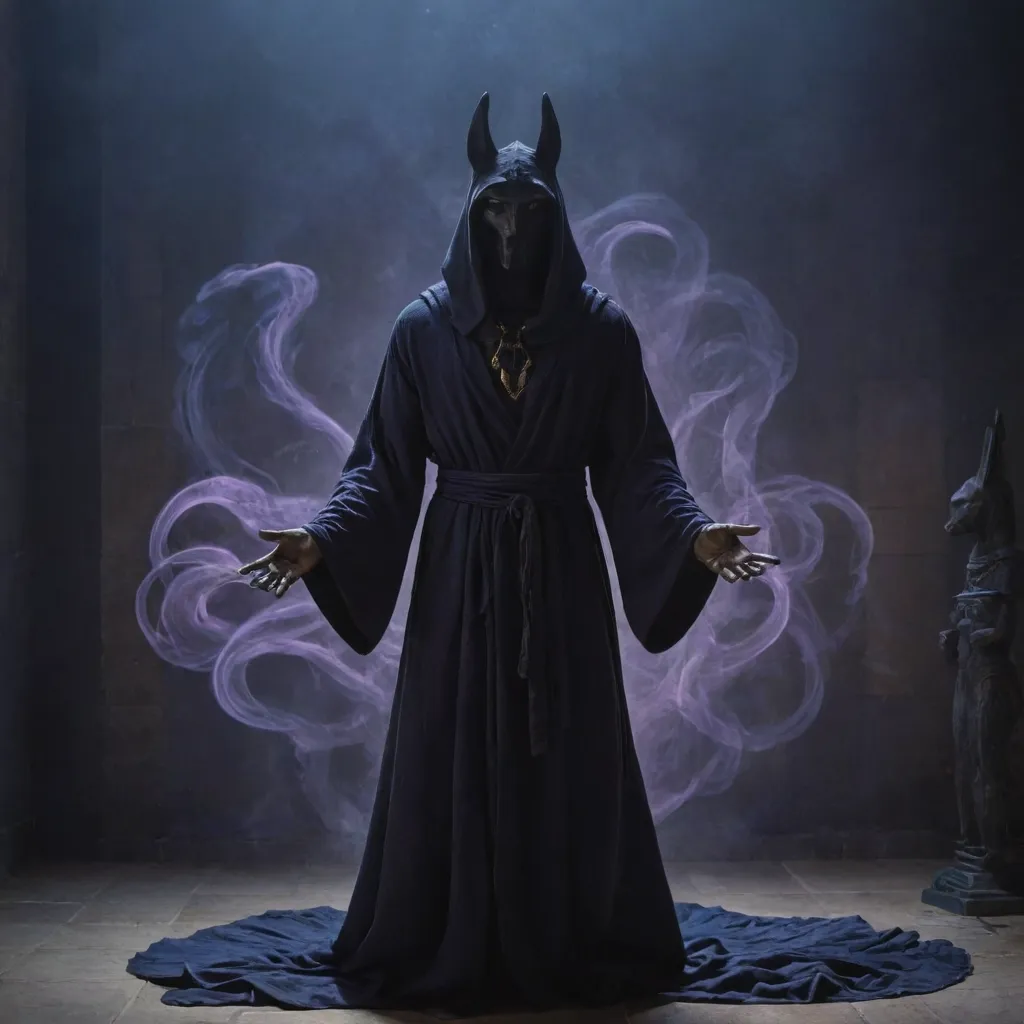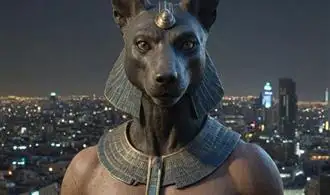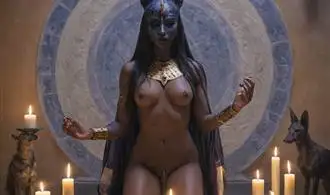
The Origin of Anubis Rituals
Anubis, the ancient Egyptian god of the dead, has long been a figure of fascination and reverence. His rituals, steeped in mystery and tradition, offer a glimpse into the rich cultural tapestry of ancient Egypt. The origins of these rituals can be traced back to the earliest dynastic periods, where Anubis played a crucial role in the afterlife rites and funerary practices of the Egyptian people.
The earliest known depictions of Anubis date back to the First Dynasty, around 3100 BCE. During this time, Anubis was already firmly established as the guardian of the dead, responsible for guiding the souls of the departed on their journey to the afterlife. This role was integral to the complex system of beliefs surrounding death and the transition to the next world.
As the civilization of ancient Egypt evolved, so too did the rituals associated with Anubis. The god's importance grew, and he became a central figure in the elaborate funerary rites that were performed for the elite and nobility. These rituals were designed to ensure the smooth passage of the deceased into the afterlife, with Anubis playing a pivotal role in the embalming process and the protection of the body.
One of the most significant Anubis rituals was the "Opening of the Mouth" ceremony, which was performed during the mummification process. This ritual was believed to restore the deceased's ability to speak, breathe, and interact with the gods in the afterlife. The high priests would use a special instrument, often a metal hook, to symbolically "open the mouth" of the mummy, ensuring the departed could partake in the eternal feast and communicate with the divine.
Another important ritual associated with Anubis was the "Weighing of the Heart" ceremony, which took place during the judgment of the dead. In this ritual, the heart of the deceased was weighed against the feather of truth, representing the moral worthiness of the individual. Anubis, as the overseer of this process, would guide the soul through the judgment, ensuring the deceased's successful transition to the afterlife.
The rituals and practices dedicated to Anubis were not limited to the elite; they were also adopted by the common people. Smaller-scale versions of the funerary rites were performed for the general population, with Anubis still playing a central role in the journey to the afterlife. These rituals were often carried out in local temples or shrines dedicated to the god, ensuring his presence was felt throughout ancient Egyptian society.
Anubis Rituals in Ancient Egyptian Funerary Practices
Anubis, the jackal-headed god, played a pivotal role in the intricate funerary practices of ancient Egypt. As the guardian of the dead and the embalming process, Anubis' rituals were integral to the journey of the deceased into the afterlife. In the complex web of ancient Egyptian beliefs, Anubis' rituals were meticulously observed to ensure the safe passage of the soul and the preservation of the physical body.
One of the most significant Anubis rituals was the embalming process. The ancient Egyptians believed that the body needed to be preserved in order for the soul to return to it. Anubis, as the god of embalming, oversaw this intricate procedure. Embalmers, known as "priests of Anubis," would carefully remove the internal organs, fill the body with natron (a salt-like substance), and wrap it in linen bandages. This process was believed to transform the body into a "mummy," a vessel that could house the soul in the afterlife.
Anubis also played a crucial role in the "Opening of the Mouth" ceremony, which was performed to restore the deceased's senses and allow them to speak, breathe, and consume offerings in the afterlife. During this ritual, the embalmer or a priest representing Anubis would touch the mummy's nose, mouth, and eyes with various tools, symbolically "awakening" the dead and preparing them for the next stage of their journey.
Another important Anubis ritual was the "weighing of the heart" ceremony, which took place in the Hall of Judgment. In this ritual, the deceased's heart was weighed against the feather of truth, symbolizing the judgment of their actions and character. Anubis presided over this ceremony, ensuring the fairness of the process and the ultimate fate of the soul.
Anubis' presence was also felt in the funerary processions and the burial of the deceased. The jackal-headed god was often depicted on coffins, sarcophagi, and other funerary objects, serving as a protector and guide for the soul on its journey to the afterlife. Additionally, small statuettes of Anubis were sometimes placed in the tomb to assist the deceased in their transition to the next life.
Modern Interpretations of Anubis Rituals
Modern interpretations of Anubis rituals have evolved significantly from their ancient Egyptian origins. While the core principles and symbolism remain, contemporary practitioners have adapted these practices to suit the needs and sensibilities of the modern world. One of the most notable shifts is the emphasis on personal spiritual growth and self-discovery, rather than solely focusing on the afterlife and the judgment of the dead.
Many modern Anubis rituals incorporate elements of meditation, visualization, and energy work to help individuals connect with the energy and wisdom of the jackal-headed god. This includes guided meditations where practitioners may envision themselves in the underworld, conversing with Anubis and seeking his guidance on personal challenges or spiritual questions. Some rituals also involve the use of Anubis-themed altar items, such as statues, candles, or incense, to create a sacred space for these transformative experiences.
Another aspect of modern Anubis rituals is the exploration of the god's role as a psychopomp, or a guide for the dead. While the ancient Egyptians focused on Anubis' role in the afterlife judgment process, contemporary practitioners may use rituals to facilitate personal transformations, letting go of the past, and embracing the journey of the soul. This can include rituals designed to help individuals process grief, release negative energy, or find closure after the loss of a loved one.
It's important to note that the interpretation and practice of Anubis rituals can vary greatly among different spiritual and esoteric traditions. Some may focus on the more ceremonial and magical aspects, while others may emphasize the psychological and therapeutic benefits. Regardless of the approach, the underlying goal of modern Anubis rituals is often to deepen one's connection with the powerful energy and wisdom of this ancient Egyptian deity. As with any spiritual practice, it's crucial to approach Anubis rituals with respect, intention, and a willingness to explore the personal and transformative aspects of this timeless figure.
Symbolism and Significance of Anubis Rituals
Anubis, the ancient Egyptian god of the dead, has long been a figure of fascination and reverence. Beyond his role as the guardian of the afterlife, the symbolism and significance of Anubis rituals offer a deeper understanding of this profound deity. Anubis was believed to be responsible for the embalming process, guiding the dead through the treacherous journey to the afterlife. The rituals associated with Anubis were not mere formalities but rather intricate ceremonies that held profound meaning and importance.
At the heart of Anubis rituals was the concept of transformation and rebirth. The embalming process, overseen by Anubis, was seen as a way to prepare the deceased for their journey to the next life. The body was carefully mummified, and various amulets and talismans were placed within the wrappings to protect and guide the soul. The jackal-headed god was believed to be present during this process, ensuring the proper preparation of the deceased.
The symbolism of Anubis rituals was rich and multifaceted. The jackal, Anubis' animal form, was closely associated with the transition between the living and the dead. Jackals were often seen prowling around cemeteries, and their ability to navigate the liminal space between the realms of the living and the dead made them a powerful symbol for Anubis. The color black, which was associated with Anubis, was also significant, representing both the fertile Nile soil and the mysterious darkness of the underworld.
The rituals themselves were complex and involved a variety of elements, each with its own symbolic meaning. The use of specific tools, such as the embalming table and various natron salts, were integral to the process. The recitation of spells and incantations by the priests, known as the "Opening of the Mouth" ceremony, was believed to restore the senses and vitality of the deceased, allowing them to partake in the afterlife.
The significance of Anubis rituals extended beyond the individual. These ceremonies were seen as essential for the maintenance of the cosmic order and the balance between the living and the dead. By ensuring the proper preparation and transition of the deceased, Anubis rituals were believed to play a crucial role in preserving the harmony of the universe.
Incorporating Anubis Rituals into Personal Spiritual Practices
Incorporating Anubis Rituals into Personal Spiritual Practices is a captivating and transformative journey for those seeking to deepen their connection with this powerful Egyptian deity. Anubis, the jackal-headed god associated with mummification, the afterlife, and the protection of the dead, offers a rich tapestry of rituals and practices that can be seamlessly integrated into one's personal spiritual journey.
At the heart of Anubis rituals lies a profound reverence for the cycle of life, death, and rebirth. By aligning oneself with Anubis, devotees can unlock a deeper understanding of the mysteries of the afterlife, and cultivate a sense of divine guidance during times of transition and transformation. This can be particularly powerful for those facing personal challenges, seeking closure, or navigating the complexities of grief and loss.
One of the most potent Anubis rituals involves the creation of an Anubis shrine or altar. This sacred space can be adorned with symbols and iconography associated with the god, such as the jackal, the ankh, or the scales of justice. Devotees can then offer prayers, light candles, or leave small offerings as a way of invoking Anubis' presence and seeking his blessings. I Mastered Anubis Iconography and So Can You provides invaluable insights into the symbolic significance of Anubis' iconography and how to incorporate it into one's ritual practices.
Another powerful Anubis ritual involves the practice of guided meditations or visualizations. By imagining themselves in the presence of Anubis, devotees can open themselves to the god's wisdom and guidance, seeking counsel on matters of the afterlife, personal transformation, or the navigation of difficult transitions. These practices can be particularly impactful when combined with the use of Anubis-related scents, such as myrrh or frankincense, which can help to create a deeply immersive and transformative experience.
















